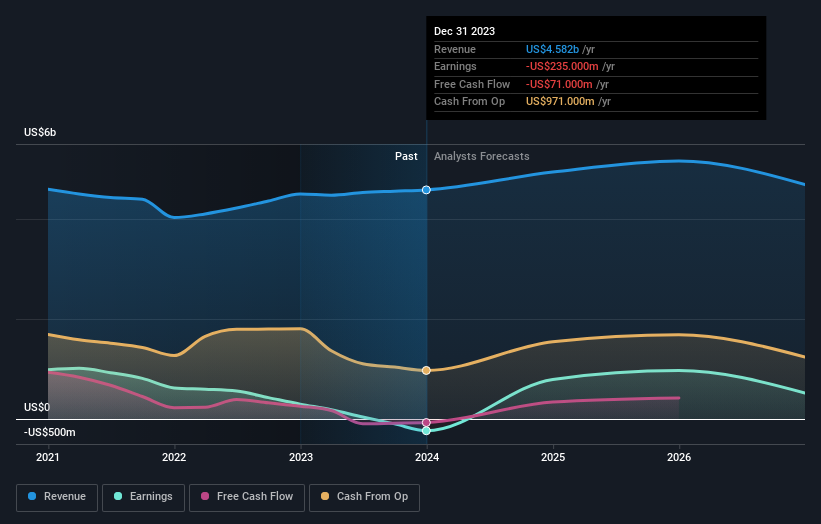Stock Analysis
- United States
- /
- Metals and Mining
- /
- NYSE:AU
Institutions profited after AngloGold Ashanti plc's (NYSE:AU) market cap rose US$467m last week but retail investors profited the most

Key Insights
- The considerable ownership by retail investors in AngloGold Ashanti indicates that they collectively have a greater say in management and business strategy
- The top 25 shareholders own 35% of the company
- Institutions own 46% of AngloGold Ashanti
To get a sense of who is truly in control of AngloGold Ashanti plc (NYSE:AU), it is important to understand the ownership structure of the business. With 54% stake, retail investors possess the maximum shares in the company. Put another way, the group faces the maximum upside potential (or downside risk).
Following a 5.5% increase in the stock price last week, retail investors profited the most, but institutions who own 46% stock also stood to gain from the increase.
In the chart below, we zoom in on the different ownership groups of AngloGold Ashanti.
View our latest analysis for AngloGold Ashanti

What Does The Institutional Ownership Tell Us About AngloGold Ashanti?
Institutions typically measure themselves against a benchmark when reporting to their own investors, so they often become more enthusiastic about a stock once it's included in a major index. We would expect most companies to have some institutions on the register, especially if they are growing.
As you can see, institutional investors have a fair amount of stake in AngloGold Ashanti. This suggests some credibility amongst professional investors. But we can't rely on that fact alone since institutions make bad investments sometimes, just like everyone does. When multiple institutions own a stock, there's always a risk that they are in a 'crowded trade'. When such a trade goes wrong, multiple parties may compete to sell stock fast. This risk is higher in a company without a history of growth. You can see AngloGold Ashanti's historic earnings and revenue below, but keep in mind there's always more to the story.

We note that hedge funds don't have a meaningful investment in AngloGold Ashanti. Van Eck Associates Corporation is currently the company's largest shareholder with 6.2% of shares outstanding. BlackRock, Inc. is the second largest shareholder owning 5.6% of common stock, and The Vanguard Group, Inc. holds about 4.0% of the company stock.
Our studies suggest that the top 25 shareholders collectively control less than half of the company's shares, meaning that the company's shares are widely disseminated and there is no dominant shareholder.
While it makes sense to study institutional ownership data for a company, it also makes sense to study analyst sentiments to know which way the wind is blowing. Quite a few analysts cover the stock, so you could look into forecast growth quite easily.
Insider Ownership Of AngloGold Ashanti
The definition of company insiders can be subjective and does vary between jurisdictions. Our data reflects individual insiders, capturing board members at the very least. Company management run the business, but the CEO will answer to the board, even if he or she is a member of it.
Insider ownership is positive when it signals leadership are thinking like the true owners of the company. However, high insider ownership can also give immense power to a small group within the company. This can be negative in some circumstances.
Our data cannot confirm that board members are holding shares personally. Given we are not picking up on insider ownership, we may have missing data. Therefore, it would be interesting to assess the CEO compensation and tenure, here.
General Public Ownership
The general public -- including retail investors -- own 54% of AngloGold Ashanti. With this amount of ownership, retail investors can collectively play a role in decisions that affect shareholder returns, such as dividend policies and the appointment of directors. They can also exercise the power to vote on acquisitions or mergers that may not improve profitability.
Next Steps:
It's always worth thinking about the different groups who own shares in a company. But to understand AngloGold Ashanti better, we need to consider many other factors.
I like to dive deeper into how a company has performed in the past. You can find historic revenue and earnings in this detailed graph.
If you are like me, you may want to think about whether this company will grow or shrink. Luckily, you can check this free report showing analyst forecasts for its future.
NB: Figures in this article are calculated using data from the last twelve months, which refer to the 12-month period ending on the last date of the month the financial statement is dated. This may not be consistent with full year annual report figures.
Valuation is complex, but we're helping make it simple.
Find out whether AngloGold Ashanti is potentially over or undervalued by checking out our comprehensive analysis, which includes fair value estimates, risks and warnings, dividends, insider transactions and financial health.
View the Free AnalysisHave feedback on this article? Concerned about the content? Get in touch with us directly. Alternatively, email editorial-team (at) simplywallst.com.
This article by Simply Wall St is general in nature. We provide commentary based on historical data and analyst forecasts only using an unbiased methodology and our articles are not intended to be financial advice. It does not constitute a recommendation to buy or sell any stock, and does not take account of your objectives, or your financial situation. We aim to bring you long-term focused analysis driven by fundamental data. Note that our analysis may not factor in the latest price-sensitive company announcements or qualitative material. Simply Wall St has no position in any stocks mentioned.
About NYSE:AU
AngloGold Ashanti
AngloGold Ashanti plc operates as a gold mining company in Africa, Australia, and the Americas.
Fair value with moderate growth potential.

